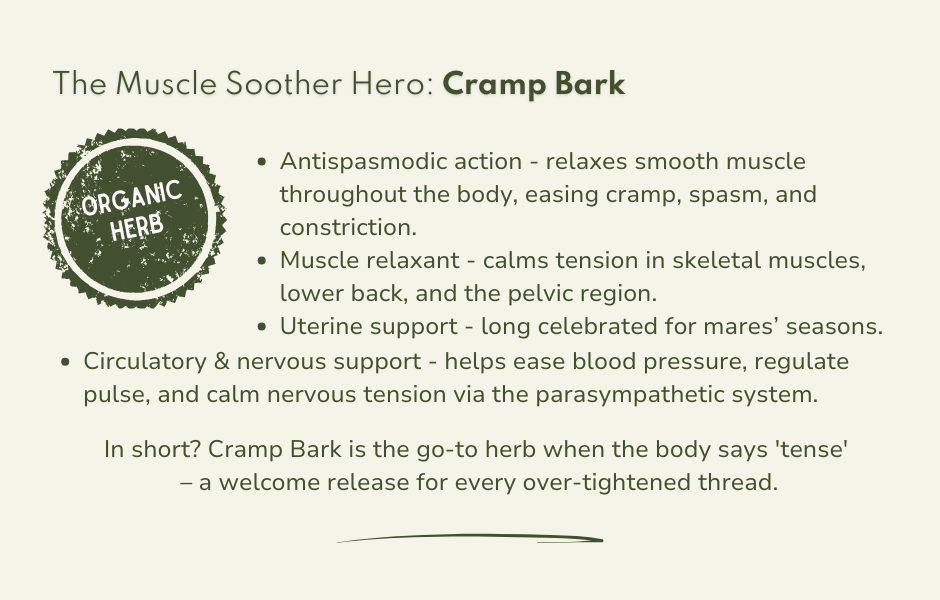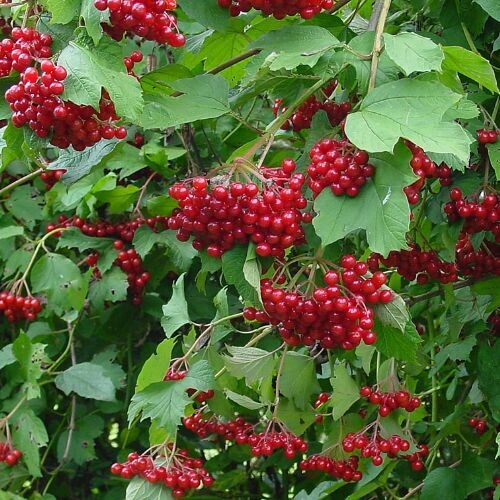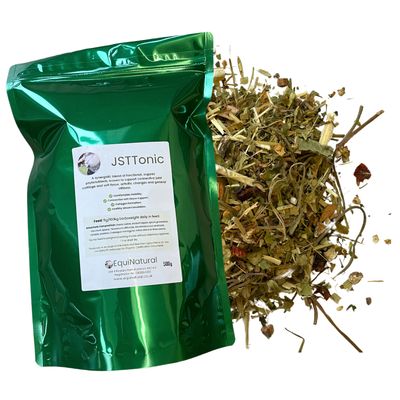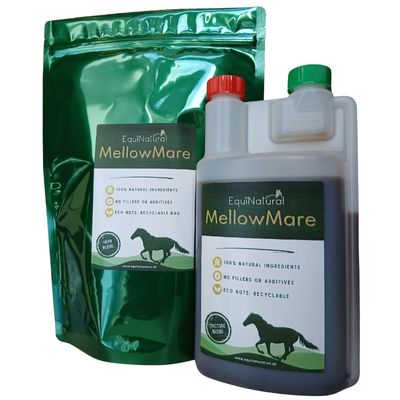CRAMP BARK (Viburnum opulus)
Benefits of Cramp Bark for Horses
The clue’s in the name - Cramp Bark is one of the most reliable herbal allies for soothing spasms, softening tension, and restoring ease to smooth muscles. From colic to cramps, this botanical brings natural calm where it’s needed most.
Please note this is a nutritional, functional horse food supplement and not veterinary medicine. For more on this, see Dr Kellon's Horse Sense - Nutrition is not 'Alternative' Therapy .
📌 Pregnant or nursing mares - always seek veterinary advice before feeding.

Find Cramp Bark in the EquiNatural range
Here’s where you’ll also find Cramp Bark in our supplement support for horses:
- JSTTonic - natural organic support for connective tissue, navicular, and arthritic changes
- MellowMare - natural organic hormone harmony for calmer, happier mares
- PSSMFlex - targeted nutritional support for muscle comfort and flexibility
💧Organic Cramp Bark Tincture
Our human-grade, certified organic tinctures give you a ready-to-absorb potent source of phytonutrients at the highest-strength available, for immediate absorption straight into the bloodstream and to the body’s cells.
- Viburnum opulus (Cramp Bark)
- Bark
- Decocted 1:3 25%
- Wild Harvested
~ Feed Guide - cramp bark tincture for horses
- 6ml/100kg bodyweight, daily in feed.
- ♻️ Our tinctures come in a heat-sealed, twin-neck, child-resistant HDPE plastic dosing bottle, complete with dosing chamber. *HDPE (High-Density Polyethylene) plastic is 100% recyclable, and energy-efficient to produce. Safe for food/water storage, it reduces waste and emissions while resisting wear. A top sustainable choice to match the EquiNatural ethos.
🌿Organic Dried Cramp Bark
Grown, harvested and dried without the use of agri-chemicals, non-irradiated and GMO free - see our Quality page for Quality Management & Certification Documents.
- Viburnum opulus (Cramp Bark)
- Bark
- Wild Harvested
- Origin E.Europe
~ Feed Guide - dried cramp bark for horses
- 5g/100kg bodyweight per day, i.e. 25g for a 500kg horse.
- Want a scoop? You can add a scoop to your basket during checkout.
- ♻️Supplied in a 100% fully recylable, resealable, food-grade foil pouch for freshness.
Footnotes
- Laboratory tested for identification and compliance to the British and European Pharmacopoeia standards.
- Human grade.
- Please be aware that if you're purchasing our dried botanicals for human use, our dried range is cut to appropriate sizes for feeding to horses.
- ♻️ Eco Note: Our packaging is recyclable and refillable.
- 🧊 Storage Tip: Keep cool and dry.
Functional Nutritional Value
Constituents: Hydroquinones, courmarins, and tannins.
Safety/Contraindications
Do not feed to the pregnant/nursing mare, or if there is a history of kidney issues.
Cramp Bark in History & Tradition
With a name like cramp bark, you already know what this amazing plant is famous for - easing spasms, softening tension, and soothing pain. A cousin of honeysuckle and elderberry, Viburnum opulus
has earned its place as one of the most trusted herbal relaxants for smooth muscle, especially in the womb and pelvic area.
Also known as guelder rose (named after a Dutch province where it was first cultivated) you've probably already met this lovely plant in hedgerows - we have it brightening up our field boundary where it's as much at home as it is working quiety in tinctures and teas.
- Herbalists as far back as King’s Dispensatory (1852) recommended cramp bark for easing cramps, spasms, asthma, and “female complaints.”
- Native American groups used related species for swollen glands, liver complaints, and even mumps, while also gathering the tart berries for food.
- In Russia and Siberia, the berries were fermented into drinks, while in Scandinavia they sweetened honey and flour pastes or were jellied as a cranberry substitute.
Despite occasional confusion in the pharmacopoeias (it was once mistakenly swapped with mountain maple!), cramp bark’s folk use has always been consistent: it relaxes, eases, and soothes.
Why herbalists love it
Cramp bark contains valerianic acid , a powerful relaxant that calms the parasympathetic nervous system. Its actions are:
- Antispasmodic – eases muscle spasms (bronchial, uterine, intestinal, urinary)
- Uterine tonic – supports menstruation, threatened miscarriage, and postpartum recovery
- Anti-inflammatory – calms irritation in muscles and mucous membranes
- Circulatory support – helps regulate pulse and ease high blood pressure
Herbalist Rosemary Gladstar calls it one of the best uterine tonics for menstrual cramps, excessive bleeding, and hormonal transitions. It's also been used for everything from bronchitis and whooping cough to cystitis, colitis, arthritis, and back pain.
Today, cramp bark is still used for:
- Menstrual pain and PMS
- Postpartum pains and uterine tension
- Lower back pain and joint stiffness
- Nervous tension, palpitations, and high blood pressure
- Topical lotions for sore, over-contracted muscles
Its unique combination of sour and acrid tastes is rare in the plant kingdom and contributes to its ability to “drive out heat” while calming spasm - a true relax-and-cool action.
Many herbalists see cramp bark as a natural alternative to ibuprofen
for menstrual cramps, joint pain, or muscular tension - soothing the body without irritating the stomach.







